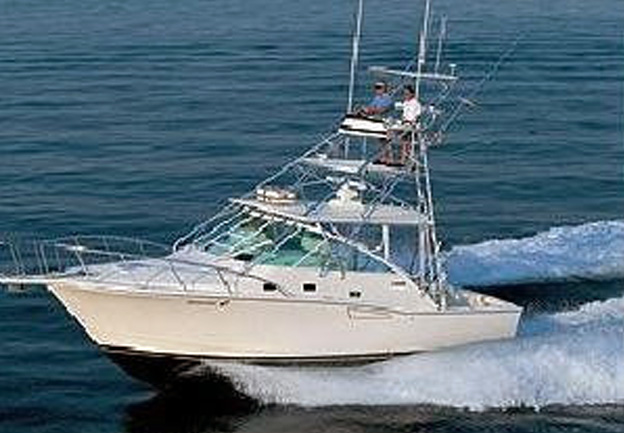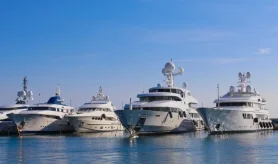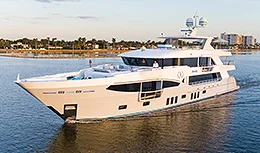- Alaskan Yachts
- Azimut Yachts
- Back Cove Yachts
- Beneteau Yachts
- Benetti Superyachts
- Bertram Yachts
- Boston Whaler
- Broward Yachts
- Buddy Davis Sportfish
- Burger Yachts
- Cabo Yachts
- Catamarans
- Carver Motoryachts
- Center Console
- Chris-Craft Yachts
- Cruisers Yachts
- DeFever Trawlers
- Dufour Sailboats
- Fairline Yachts
- Feadship Yachts
- Ferretti Yachts
- Filippetti Yachts
- Formula Yachts
- Fountaine Pajot Cats
- Grady-White
- Grand Banks Trawlers
- Hargrave Yachts
- Hatteras Yachts
- Hinckley Picnic Boats
- Horizon Yachts
- Hydra-Sports
- Intrepid Boats
- Jarrett Bay Sportfish
- Jeanneau Yachts
- Kadey-Krogen Trawlers
- Lazzara Yachts
- Lekker Boats
- Luhrs Sportfish
- Marlow Yachts
- Maritimo Yachts
- Marquis Yachts
- Mazu Yachts
- McKinna Motoryachts
- Meridian Yachts
- Midnight Express
- MJM Yachts
- Mochi Craft
- Neptunus Motoryachts
- Nordhavn Trawlers
- Nordic Tugs
- Numarine Yachts
- Ocean Alexander Yachts
- Ocean King
- Offshore Yachts
- Outer Reef
- Oyster Sailing Yachts
- Pacific Mariner Yachts
- Palmer Johnson Yachts
38/39 Hatteras Convertible
![]()

Source: Jack Hornor, BoatUS Magazine
Over the last 40-plus years, Hatteras Yachts of Highpoint, NC, has worked to establish a worldwide reputation for building some of the finest recreational boats offered. The success of their effort is borne out in a recent survey of BoatU.S. members who ranked Hatteras at the top of their wish list of boats they would someday like to own. The Hatteras 38/39 Convertible is a classically styled, dual purpose (fishing and cruising) boat that would likely fulfill many of their wishes.
Designed by Hatteras’s in-house design team and introduced in 1988 as the Hatteras 38 Convertible, the model remained basically unchanged until the 1994 model year when it was restyled slightly, the interior modernized and the name changed to the Hatteras 39 Convertible. Production was discontinued following the 1998 model year. This was the last of the mid-sized model boats to be offered by Hatteras.
The hull form is a modified “V” with an integral keel that aids in tracking and directional stability, particularly at slower speeds. The modest deadrise of only about nine degrees at the transom helps the boat to lift onto plane with less horsepower, and roll less at slow speed or sitting still.
Construction is fiberglass reinforced plastic (FRP) composite. The hull is solid glass fiber and resin below the waterline. Foam cored composites are used above the waterline, except in the area of through hull fittings. Longitudinal stringers, athwartship stiffeners and major structural bulkheads are installed before the hull is removed from the mold to ensure hull shape is retained when it is removed. The deck and hull are fastened together in a shoebox fashion with adhesives and mechanical fasteners. The quality of engineering, materials and construction of this model is excellent and I know of no common problems, aside from those associated with wear and tear due to age and service.
Unlike most boatbuilders, Hatteras paints the exterior of their boats rather than using a pigmented resin (gelcoat) finish. These finishes, first developed for the aircraft industry, last as long if not longer than gelcoat and are not as prone to oxidation and chalking.
Although not unique to Hatteras, fuel tanks are constructed of fiberglass rather than welded aluminum or steel. This eliminates the potential for corrosion associated with metal tanks and is stronger and more durable than molded plastic tanks. But there have been some rather serious problems associated with fiberglass tanks and the use of gasoline/ethanol fuel. This should not be much of a problem because nearly all 38/39 Convertibles were built with diesel engines. Only in the first year of production was the 38 Convertible offered with gasoline engines and I have never run across one.
As with any design that is intended to serve more than one function — in this case fishing and cruising — there are compromises in the design. For example, the 103-square-foot cockpit allows for the installation of a full-size fighting chair for the sportfishing enthusiast but, with such a chair in place, there is not much room for dockside entertaining. The flybridge is arranged with the helm and mate seats aft, as they should be on a fishing boat, so that the operator can easily see what’s going on in the cockpit. The helm console provides plenty of room for navigation electronics and a bench seat forward where two or three passengers can be comfortably seated. The flush and unobstructed foredeck provides a great spot for the sun worshiper when dockside or at anchor.
The cabin arrangement of both models provides a master stateroom forward with center-island queen bed. On both models this is followed along the port side by the head, although the arrangement of the head and shower is slightly different on the models and slightly smaller on the 39. Opposite the head, the 38 has a separate guest stateroom with bunk berths which is very tight. On the 39, the door and bulkhead that separated the second stateroom were eliminated and the bunks replaced by a settee and fold down upper berth.
In the parlance of the sportfishing community, the 38/39 Convertible is what is called a “galley up” model which means that the galley is on the same level as the main saloon and usually over the engines. The original arrangement featured a very small galley forward along the port side and seating to starboard. The redesign included an enlarged U-shaped port galley, by most accounts an improved arrangement.
As was noted earlier, in 1988 the 38 Convertible was offered with the option of 350-hp Crusader gasoline engines or 475-hp GM 6-71 diesel engines. After 1988 only GM 6-71s were installed. With the redesign in 1994, again several engine options were offered but all were diesel. Of the 13 boats I found currently offered for sale and the five boats sold in the last year all but one were equipped with GM 6-71 engines. By today’s sportfisherman standards, the 38/39 is a bit slow with a cruising speed of about 20 knots and a top speed of about 25 knots.
For shoppers, there are usually several Hatteras 38/39 Convertibles to choose from in most major boating centers. A recent search of Internet sites turned up 13 boats offered for sale with nine located in the continental U.S., one in Hawaii and three in Europe. Asking prices ranged from $149,000 for a 1988 Florida boat to $325,000 for a 1995 model in Connecticut. Reported U.S. sales, over the last year, have ranged from $166,000 for a 1988 Texas boat to $242,000 for a 1997 boat in Massachusetts.
One word of caution — if you search for Hatteras models in this size and age range you are likely to also turn up their 39 Express also made from 1994 to 1998. While this is built on the same hull, it should not be confused with the “Convertible” model.
Although Hatteras continues to build some of the finest production and semi-custom recreational boats made, their recent direction is towards larger models, the smallest of which is a 50-footer costing over $1 million. The Hatteras 38/39 may be the last model in the Hatteras line that remains reasonably sized and affordable.



